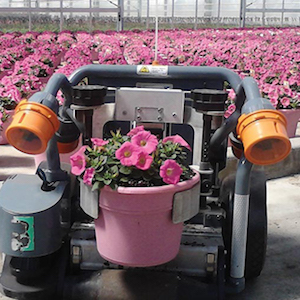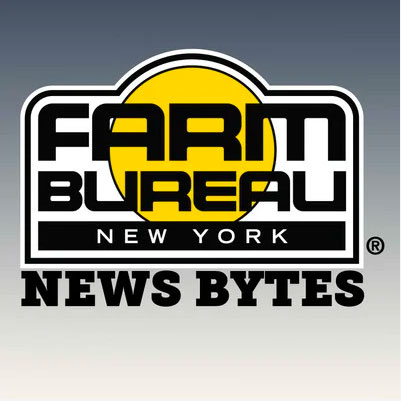Robots in Agriculture: Innovating Our Way to a More Sustainable Future
by Seth Moser-Katz
NYFB Content Creator
 Throughout America, farmers continue to struggle in the search to find and retain employees for seasonal positions. Due primarily to the shift in the American workforce away from agriculture, the Bureau of Labor Statistics estimates that less than 2% of Americans work in agriculture and this number is expected to continue to decline. Most every farmer will tell you, it’s more challenging than ever to find dependable farm labor.
Throughout America, farmers continue to struggle in the search to find and retain employees for seasonal positions. Due primarily to the shift in the American workforce away from agriculture, the Bureau of Labor Statistics estimates that less than 2% of Americans work in agriculture and this number is expected to continue to decline. Most every farmer will tell you, it’s more challenging than ever to find dependable farm labor.
This scarcity of manual labor threatens not only agricultural businesses but has the capacity to endanger food security and force the United States to rely more heavily on other nations to feed the population.
As agriculture continues into its fourth revolution, one marked by computer vision, AI, and robots, innovation, and progress are helping to push farming into a highly technological future. Robots continue to gain functionality in more and more complicated tasks and slowly we are beginning to see these machines show up in the fields.
Green House Movers: Harvest Automation - HV-100
As Christmas time rolls around, the tens of thousands of Poinsettias, sold along the east coast to big box retailers, must be spaced. A grower often has barely one week to accomplish repositioning. Traditionally, this has meant that throngs of workers must drop their other crucial duties and support spacing the Poinsettia crop. Working a 20-hour day, a single robot can space an average of more than 2,500 plants per day.
With minimal programming, the HV-100 is capable of plant spacing, consolidation, and collection needs in a nursery or greenhouse operation. They are adaptable to open beds, hoop houses, and greenhouses with any type of plant, on all common ground surfaces. The robots provide reliable spacing precision no matter how long the day is, without breaks, allowing cultivators to get work accomplished whenever needed.
Robotics-As-A-Service (RaaS): Verdant Robotics SprayBox
After providing autonomous cars and Mars rovers, the founders of Verdant Robotics were looking for a new intellectual challenge that would also offer a constructive effect on upcoming generations. Employing computer vision, artificial intelligence, robotics, GPS navigation, chemistry, soil, and plant sciences, they produced SprayBox.
SprayBox can precisely focus on individual weeds and crops at a rate of 20 plants per second, before hitting them with either a de-weeder or fertilizer within a millimeter of accuracy. The robot can identify and care for 500,000 plants per hour while using 95% less chemical weedkiller. As the robot moves over a field, high-res cameras scan every living plant and create a digital copy of the entire farm. This allows the robot to geolocate each plant allowing farming at the centimeter level and farm every plant separately
Verdant’s multi-action autonomous platform is the only ag robot in the U.S. market that can simultaneously weed, fertilize, and treat plants for pests and diseases – all while collecting data on every plant, permitting farmers to make key choices in real-time.
Robots-as-a-service (RaaS) is a business model in which robotics companies offer the use of their robot devices via a subscription-based contract. As robotic adoption increases, more and more companies are seeing the value of the RaaS model to reduce risk and provide scalable solutions for customers.
Fruit Picking in the Future: Tevel Aerobotics - Flying Autonomous Robots
Tevel, based in Tel Aviv, Israel, has created a patented platform called FAR (Flying Autonomous Robots) that is a blend of actual flying robots, algorithms, AI, and data analytics. The flying robots are outfitted with computer vision and AI that detects fruit and foliage and recognizes the type of fruit, size, and ripeness. Attached to the drone is a three-foot-long suction head for re-moving the fruit from the tree. Additionally, the small drones are capable of other tasks like pruning, trimming, and thinning of orchard trees.
The precise and innovative way the fruit is removed from the tree prevents bruising while the AI vision offers data from each robot as it picks fruit, in real-time. Growers can now monitor in the contents of each bin as it is being filled: total fruit weight, size and weight distribution of fruits, color grading, ripeness, and more.
Conclusion: The Past is our Future
Increasingly, farmers are turning towards, cover cropping, intercropping, and other regenerative agriculture techniques that allow them to keep the soil healthy. Intercropping places different crops in a single field, which creates a more robust ecosystem and a sense of balance between plants.
The obstacle has always been that it’s challenging to do this sort of farming at the same scale that growers can do monocropping. But because robots are developing the ability to farm each plant individually, it could theoretically allow these types of regenerative ag methods at commercial scales.
Ironically, this is returning to how farming was done a hundred years ago, revitalizing the expertise that older farmers had and bringing it back through technology. The exciting part is we’re just at the very beginning of this stage in agriculture and the impacts of this digital revolution in agriculture have yet to begin.
Photo 1: With minimal programming, the HV-100 is capable of plant spacing, consolidation, and collection needs in a nursery or greenhouse operation.
Photo 2: Flying autonomous robots (FAR) are outfitted with computer vision and AI that detects fruit and foliage and recognizes the type of fruit, size, and ripeness.



